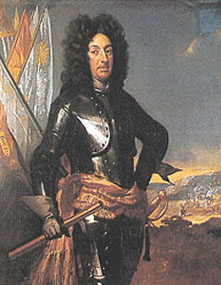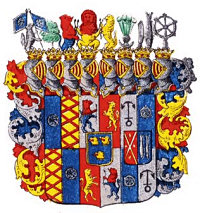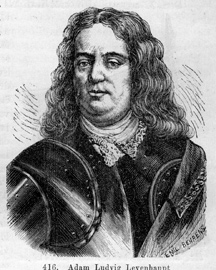|
 Count Adam Ludwig Lewenhaupt (Leijonhufvud in Swedish) (1659 - 1719) was a Swedish General
of the Infantry, a well educated and
religious aristocrat who was born in a Swedish fortified camp near Copenhagen. He was the son of Count Ludwig Wierich Lewenhaupt, a major-general, and
Countess Charlotta Susanna Maria of Hohenlohe and Gleichen. Until the beginning of his military career he attended Lund University (1671), Uppsala University
(1675) and Rostock University (1680). His first career choice was the diplomatic corps rather than the army. In 1684 Adam Lewenhaupt accompanied his
brother-in-law, Konrad Gyllensierna, who was a member of the Swedish Embassy, to Moscow. When he was unable to find a position as a diplomat, Lewenhaupt
instead entered the military. While a cornet in Nils Bielke’s cavalry regiment, he participated in the campaign against the Turks under the command of the Elector
of Bavaria (1685). From 1686 until 1697 he served in the Dutch military. He left Dutch service in 1698 with the rank of colonel and joined the Swedish army on the
eve of the Great Northern War.
Count Adam Ludwig Lewenhaupt (Leijonhufvud in Swedish) (1659 - 1719) was a Swedish General
of the Infantry, a well educated and
religious aristocrat who was born in a Swedish fortified camp near Copenhagen. He was the son of Count Ludwig Wierich Lewenhaupt, a major-general, and
Countess Charlotta Susanna Maria of Hohenlohe and Gleichen. Until the beginning of his military career he attended Lund University (1671), Uppsala University
(1675) and Rostock University (1680). His first career choice was the diplomatic corps rather than the army. In 1684 Adam Lewenhaupt accompanied his
brother-in-law, Konrad Gyllensierna, who was a member of the Swedish Embassy, to Moscow. When he was unable to find a position as a diplomat, Lewenhaupt
instead entered the military. While a cornet in Nils Bielke’s cavalry regiment, he participated in the campaign against the Turks under the command of the Elector
of Bavaria (1685). From 1686 until 1697 he served in the Dutch military. He left Dutch service in 1698 with the rank of colonel and joined the Swedish army on the
eve of the Great Northern War.
 Given the command of the Uppland, Västmanland and Dalarna regiments, he proved himself to be a reliable but uninspired commander.
By 1703 he had risen to the rank of Major-General of Infantry and was appointed governor of Courland, Pilten and Samogitia. In 1705 Lewenhaupt won the Battle of
Gemauerthof and was appointed governor of Riga. By 1706 he had risen to the rank of General of Infantry and had been appointed General-in-Chief of the standing
army in Livonia, Courland and Lithuania, holding these Swedish possessions for the Crown. As a commander, he was considered cautious and considerate of the
welfare of his men. In 1708, he was ordered to march east with a supply column, to support Charles's primary invasion force in Russia. This led to the Battle of
Lesnaya (1708), in which he was defeated and forced to abandon his supplies. His handling of the supply column during the Russian campaign has been criticized
as lethargic, and its delay in reaching the King's army is seen as the cause of the subsequent disaster. This is an unfair assessment given the logistical problems
he faced. In the Battle of Poltava on June 27th 1709, General Lewenhaupt was in command of the Swedish infantry. After passing the line of the Russian redoubts
he regrouped his units and sought to advance to the nearest corner of the Russian fortified camp.
Given the command of the Uppland, Västmanland and Dalarna regiments, he proved himself to be a reliable but uninspired commander.
By 1703 he had risen to the rank of Major-General of Infantry and was appointed governor of Courland, Pilten and Samogitia. In 1705 Lewenhaupt won the Battle of
Gemauerthof and was appointed governor of Riga. By 1706 he had risen to the rank of General of Infantry and had been appointed General-in-Chief of the standing
army in Livonia, Courland and Lithuania, holding these Swedish possessions for the Crown. As a commander, he was considered cautious and considerate of the
welfare of his men. In 1708, he was ordered to march east with a supply column, to support Charles's primary invasion force in Russia. This led to the Battle of
Lesnaya (1708), in which he was defeated and forced to abandon his supplies. His handling of the supply column during the Russian campaign has been criticized
as lethargic, and its delay in reaching the King's army is seen as the cause of the subsequent disaster. This is an unfair assessment given the logistical problems
he faced. In the Battle of Poltava on June 27th 1709, General Lewenhaupt was in command of the Swedish infantry. After passing the line of the Russian redoubts
he regrouped his units and sought to advance to the nearest corner of the Russian fortified camp.
 However, Field Marshal Karl Rehnsköld considered
Lewenhaupt’s plan to attack without the support of the cavalry to be foolhardy and ordered to called it off. Many historians still consider this decision a fatal error.
Close to the end of the battle, when Lewenhaupt’s infantry troops were surrounded by the superior enemy forces, the battle turned into a slaughter. He avoided
being taken prisoner or killed, and finally joined the remnants of the Swedish army in the village of Pushkarivka. He was in command of the Swedish army during
its retreat southward. His decision to surrender the remainder of the army at Perovolochna on the Dnieper River, thereby avoiding needless bloodshed, demonstrated
his concern for his troops. He died a prisoner-of-war in Moscow. “Leijonhufvud,” his monumental apologia for the defeat at Poltava which he wrote in Russian captivity,
is a Swedish version of his name that can be translated as “Lion’s Head.”
However, Field Marshal Karl Rehnsköld considered
Lewenhaupt’s plan to attack without the support of the cavalry to be foolhardy and ordered to called it off. Many historians still consider this decision a fatal error.
Close to the end of the battle, when Lewenhaupt’s infantry troops were surrounded by the superior enemy forces, the battle turned into a slaughter. He avoided
being taken prisoner or killed, and finally joined the remnants of the Swedish army in the village of Pushkarivka. He was in command of the Swedish army during
its retreat southward. His decision to surrender the remainder of the army at Perovolochna on the Dnieper River, thereby avoiding needless bloodshed, demonstrated
his concern for his troops. He died a prisoner-of-war in Moscow. “Leijonhufvud,” his monumental apologia for the defeat at Poltava which he wrote in Russian captivity,
is a Swedish version of his name that can be translated as “Lion’s Head.”
|
 History
History
 Dates and events
Dates and events
 Persons
Persons
 Poltava
Poltava
 Sights
Sights
 Photo gallery
Photo gallery
 Maps
Maps
 Virtual Museum
Virtual Museum
 Armament
Armament
 Uniforms
Uniforms
 Coins and medals
Coins and medals
 Flags
Flags
 Paintings
Paintings
 Poltava photographs
Poltava photographs
 News
News
 About us
About us
 Acknowledgments
Acknowledgments
 Main page
Main page
 top
top ...back
...back  History
History
 Dates and events
Dates and events
 Persons
Persons
 Poltava
Poltava
 Sights
Sights
 Photo gallery
Photo gallery
 Maps
Maps
 Virtual Museum
Virtual Museum
 Armament
Armament
 Uniforms
Uniforms
 Coins and medals
Coins and medals
 Flags
Flags
 Paintings
Paintings
 Poltava photographs
Poltava photographs
 News
News
 About us
About us
 Acknowledgments
Acknowledgments
 Main page
Main page